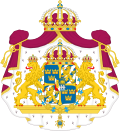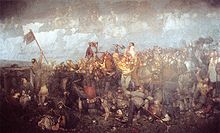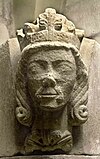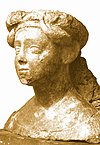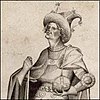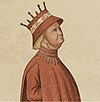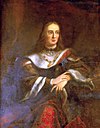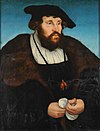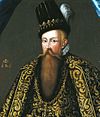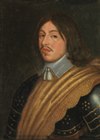
Eric XIV was King of Sweden from 1560 until he was captured in a rebellion led by his brother John in 1568 and formally deposed 26 January 1569. Eric XIV was the eldest son of Gustav I (1496–1560) and Catherine of Saxe-Lauenburg (1513–1535). He was also ruler of Estonia, after it placed itself under Swedish protection in 1561.

Sten Sture the Younger, was a Swedish nobleman who served as the regent of Sweden, during the era of the Kalmar Union.

Sture was a name borne by three distinct but interrelated noble families in Sweden in the Late Middle Ages and Early Modern Period. It was originally a nickname, meaning 'haughty, proud', but later became a surname. Particularly famous are the three regents from these families who ruled Sweden in succession during the fifty-year period between 1470 and 1520, namely:

The Instrument of Government of 1634 was a document describing the form and operation of the Swedish government, retrospectively regarded as the country's first constitution, although it was not intended to function as such. It was composed by the Lord High Chancellor, Axel Oxenstierna, and was adopted by the Riksdag of the Estates on 29 July 1634. It was rendered void when the Riksdag repudiated it in 1680.

Eric XI Ericsson or Eric the Lisp and Lame was King of Sweden from 1222 to 1229 and again from 1234 to 1250. Being the last ruler of the House of Eric, he stood in the shadow of a succession of powerful Jarls, especially his brother-in-law Birger Jarl, whose descendants ruled as kings after his death.

Eric the Victorious was a Swedish monarch as of around 970. Although there were earlier Swedish kings, he is the first Swedish king in a consecutive regnal succession, who is attested in sources independent of each other, and consequently Sweden's list of rulers usually begins with him. His son Olof Skötkonung, however, is considered the first ruler documented to definitely have been accepted both by the original Swedes around Lake Mälaren and by the Geats around Lake Vättern. Adam of Bremen reports a king named Emund Eriksson before Eric, but it is not known whether he was Eric's father. The Norse sagas' accounts of a Björn Eriksson are considered unreliable.

Engelbrekt Engelbrektsson was a Swedish nobleman, rebel leader and military leader of German ancestry. He was the leader of the Engelbrekt rebellion in 1434 against Eric of Pomerania, king of the Kalmar Union. Engelbrekt Parish and Engelbrekt Church (Engelbrektskyrkan) in the Church of Sweden Diocese of Stockholm were both named in his honor.

Eric X was King of Sweden between 1208 and 1216. Also known as Eric the Survivor, he was, at his accession to the throne, the only remaining son of King Canute I of Sweden and his queen. The name of his mother is not known, but may have been Cecilia.
Sverker II or Sverker the Younger was King of Sweden from 1195 or 1196 to 1208 when he was defeated in the Battle of Lena by Prince Eric. Sverker died in the 1210 Battle of Gestilren where his forces battled those of King Eric X.

Håkan the Red was a King of Sweden, reigning for about half a decade in the second half of the 11th century. There is little information on him, and it is mostly contradictory. Nothing is known about his reign.

Kol was a Swedish prince who, together with his brother Burislev was a contender for the throne of Sweden from 1167 until his violent death a few years later. The struggle was a stage in the rivalry between the House of Sverker, to which Kol and Burislev belonged, and the House of Eric.

Bishop Benedict, Duke of Finland was a Swedish prelate bishop and duke.
The Lord High Constable was a prominent and influential office in Sweden, from the 13th century until 1676, excluding periods when the office was out of use. The office holder was a member of the Swedish Privy Council and, from 1630 and on, the head of the Swedish Council of War. From 1634, the Lord High Constable was one of five Great Officers of the Realm.

Gunilla Bielke; Swedish: Gunilla Johansdotter Bielke af Åkerö was Queen of Sweden as the second wife of King John III. Queen Gunilla is acknowledged to have acted as the political adviser to John III and to have influenced his religious policies in favour of Protestantism.
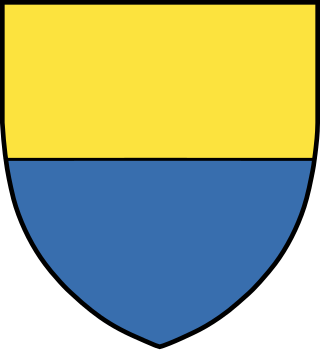
The Natt och Dag is a Swedish noble family and the oldest surviving family of pure Swedish extraction, with origins stretching back at least as far as the late thirteenth century. However, the actual name Natt och Dag, alluding to the contrasting colours of its coat of arms, was not coined until the sixteenth century, and was not used as a surname by the family itself until the eighteenth century It is therefore customary to write the name in parentheses when applying it to individuals prior to 1700.
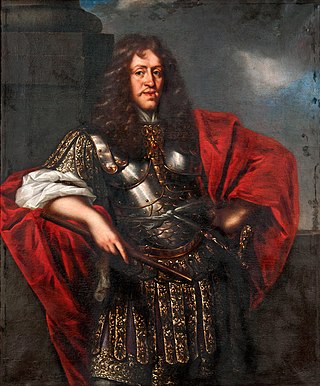
Adolph John I was Count Palatine of Kleeburg from 1654 until 1689 and was considered Prince of Sweden until 1660. He was the younger brother of King Charles X Gustav of Sweden.
Martha Eriksdotter Leijonhufvud, known as Kung Märta, was a politically-active Swedish noblewoman. She was the sister of Queen Margaret Leijonhufvud and sister-in-law of King Gustav I of Sweden: she was also the maternal aunt of Queen Catherine Stenbock and the daughter-in-law of the regent Christina Gyllenstierna. In 1568, she financed the deposition of King Eric XIV of Sweden, which placed her nephew John III of Sweden on the throne.
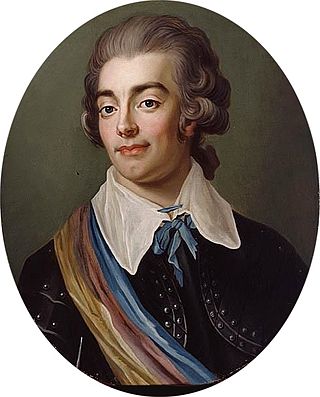
Adolf Ludvig Stierneld, Baron Stierneld was a Swedish nobleman, courtier and collector of historical documents. Recent historical research has revealed him to be one of best and most prolific document forgers in Swedish history.

Duke Erik Birgersson was a Swedish duke of the House of Bjelbo (Folkungaätten).
Eric and Eric, according to Adam of Bremen, were two contenders for the kingship of Sweden around 1066–67, after the death of King Stenkil. They waged war on each other, with disastrous consequences: "[I]n this war all the Swedish magnates are said to have fallen. The two kings also perished then. When the entire royal clan was thus entirely extinct, conditions in the kingdom were changed and Christianity was disturbed to a high degree. The bishops that the Archbishop [of Bremen] had anointed for this land stayed back home due to fear of persecutions. Only the bishop in Scania took care of the churches of the Geats, and the Swedish Jarl Gnif strengthened his people in the Christian faith."
